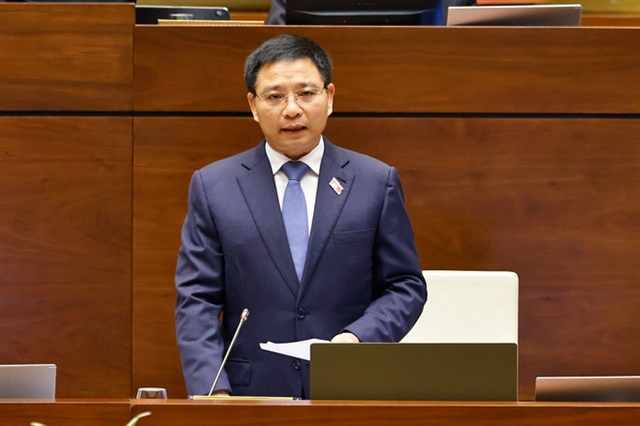To help the SOEs achieve their targets, the finance ministry has reformed and amended several legal regulations, such as the Enterprise Law, the Investment Law, the Bidding Law and tax laws, to unlock resources and increase the operation efficiency of SOEs.

HÀ NỘI — Finance Minister Nguyễn Văn Thắng has outlined solutions to achieve a GDP growth of at least 8 per cent in 2025 during the question-and-answer session of the National Assembly (NA)’s 9th meeting on Thursday.
At the Q&A session, deputy Trần Kim Yến from HCM City asked the minister about the disbursement of public investment to meet the Government's 8 per cent GDP growth target for 2025.
According to Yến, the Government's growth target is a huge challenge, requiring great determination and new ways of thinking. One of the solutions proposed by the Ministry of Finance is to more effectively use public investment channels to disburse 100 per cent of planned capital. However, despite a great effort, the public investment disbursement rate so far this year has remained very low. The deputy said she expected the Minister to propose more feasible solutions to help achieve the ambitious growth target.
Minister Thắng responded agreeing that the target of disbursing 100 per cent of public investment capital this year would be a big challenge.
According to Thắng, disbursement figures are low because the disbursement rate is often low at the beginning of the year. Meanwhile, the disbursement process has many stages, and if a problem is encountered at any stage, it will halt the entire process. In addition, the supply of raw materials for public investment projects is still lacking, while capacity for implementing the projects in some localities has remained limited.
However, in the first five months of the year, the disbursement rate reached nearly VNĐ200 trillion, accounting for about 24.1 per cent of the goal. This rate is higher than it was last year (up 22 per cent), and key national projects are all being completed either on schedule or even faster.
As for solutions, Thắng said that the Government would focus on removing legal obstacles in implementing public investment, including an amendment of the Law on Public Investment to increase localities' authority to handle obstacles for public investment projects.
The minister also noted that disbursement figures would also be an important basis for evaluating the performance of provincial officials.
Responding to a question from Yên Bái Province deputy Khang Thị Mào about solutions for State-owned enterprises (SOEs) to achieve a growth target of at least 8 per cent, moving towards double digits in the following years, Minister Thắng said that the Ministry of Finance had directed 18 SOEs to adjust their growth goals up to 8 per cent or more.
“The State only manages the contributed capital of SOEs, and SOEs have the right to autonomy in terms of salaries, bonuses, income, capital increases and many other items. Therefore, SOEs must renew their thinking and proactively make the most of capital resources to implement business strategies to achieve the highest results in terms of profit, revenue and network scale,” Thắng said.
To help the SOEs achieve their targets, the finance ministry had reformed and amended several legal regulations, such as the Enterprise Law, the Investment Law, the Bidding Law and tax laws, to unlock resources and increase the operation efficiency of SOEs, the minister said.
Two million enterprises
Meanwhile, deputy Đặng Bích Ngọc from Hòa Bình Province asked: "As the production and business activities of enterprises are facing many difficulties due to global economic uncertainties, it will create more pressure on the Government’s target of having two million enterprises operating in the economy by 2030. As the leader of the finance sector, what solutions does the minister have to meet the target?"
Thắng answered that the target of reaching two million enterprises by 2030 set in the Politburo’s Resolution 68 was a very important goal for socio-economic development, demonstrating strong economic growth aspirations. However, it was also a huge challenge, since consumption demand was declining, the domestic and global business environment still faced many difficulties and the competitiveness of many enterprises was still weak.
"We saw that in the first five months of this year, the number of enterprises withdrawing from the market was very large. This is a huge challenge for us," Thắng noted.
Faced with this situation, the leader of the financial sector proposed three solutions.
First, Thắng emphasised the role of creating a favourable, transparent and effective business environment, and focusing on removing barriers, especially cutting administrative procedures and reducing compliance costs. It was also necessary to remove obstacles in property investment, construction and planning, which would help create an open and stable corridor for businesses.
"Along with the current trend, we must also promote the digital transformation in management to create the most favourable conditions for businesses," the minister noted.
He added: “We must promote the process of converting household businesses into enterprises. Currently, there are more than five million household businesses in operation. This shows great potential to realise the goal of two million enterprises by 2030.
"We are reviewing the legal framework to narrow the gap between household businesses and enterprises, and implementing a plan to abolish lump-sum taxes from 2026 to strongly promote transparency and professionalisation." — BIZHUB/VNS
- Tags
- National Assembly





